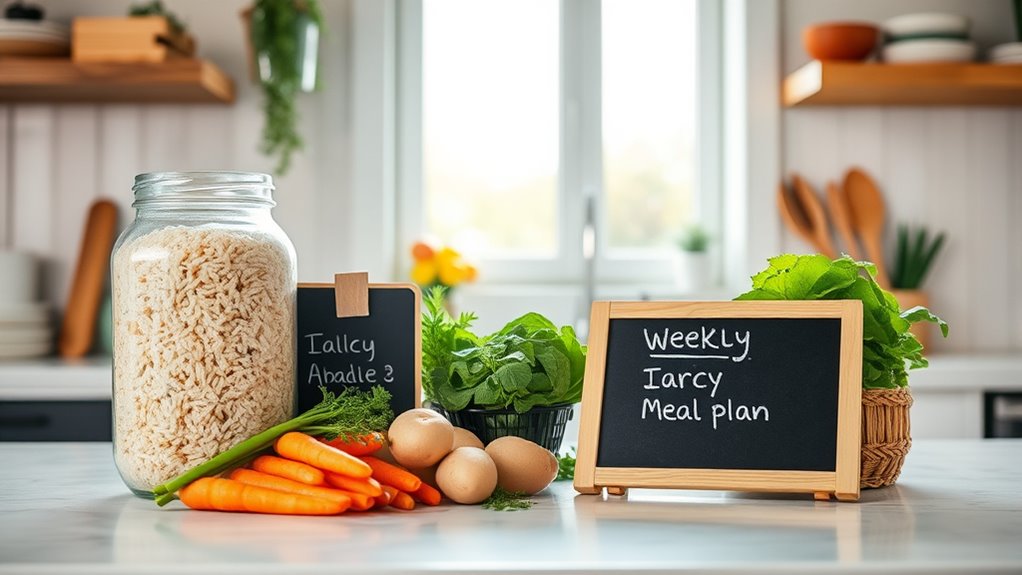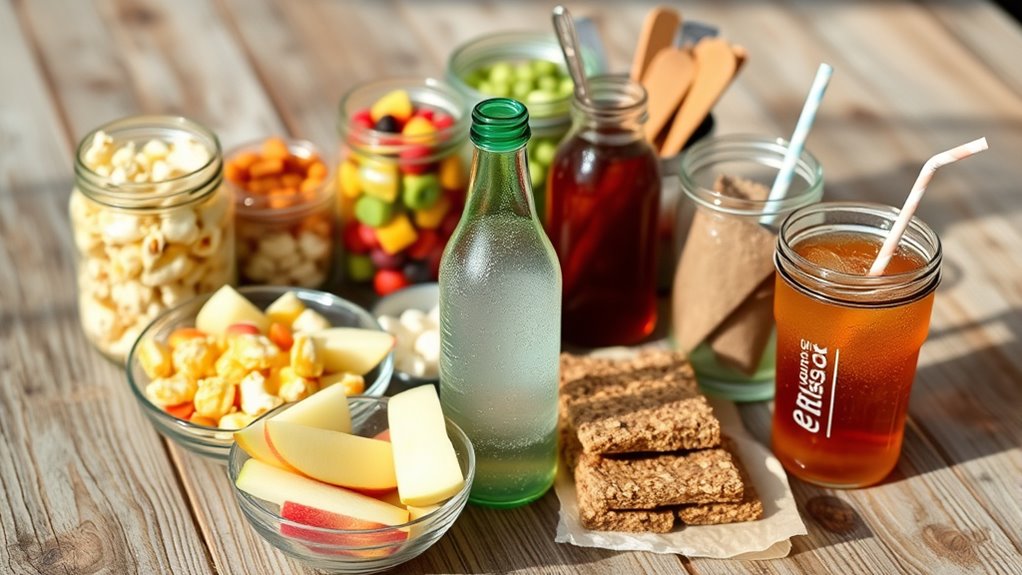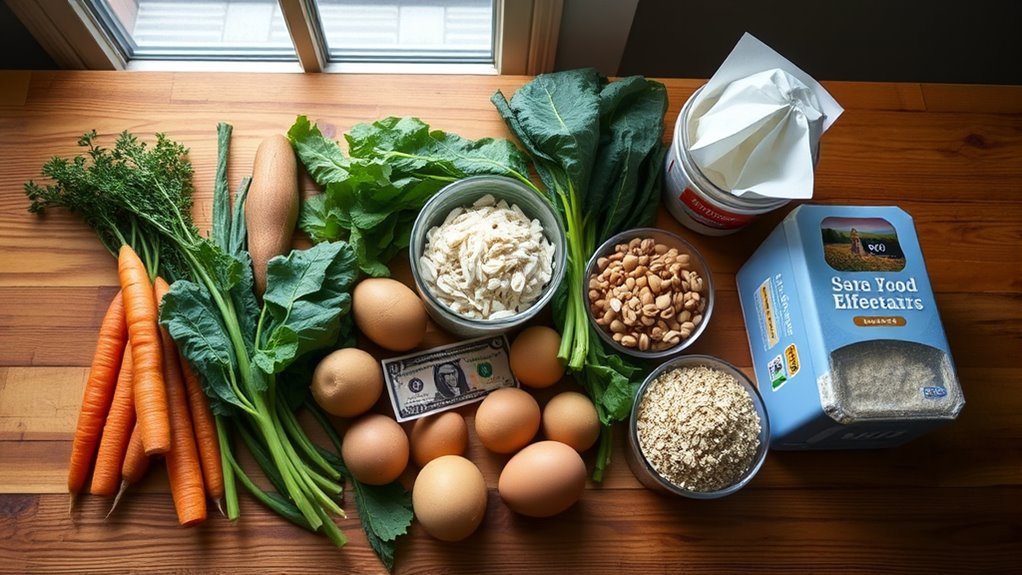If you’re on a fixed income, sticking to a $50 weekly food budget is doable with smart planning and shopping. Focus on simple, nutritious staples like rice, beans, seasonal produce, and affordable proteins like eggs. Plan meals ahead, buy in bulk, and look for sales to stretch your dollars. Batch cook and store leftovers to reduce waste. Keeping track of your expenses helps stay within budget. Explore these strategies further to make the most of your limited funds.
Key Takeaways
- Plan meals around versatile, budget-friendly staples like rice, beans, and seasonal produce to maximize nutrition and savings.
- Shop strategically by using coupons, store sales, bulk buying, and comparing prices to stay within the $50 weekly limit.
- Incorporate batch cooking and leftovers to reduce time, waste, and additional costs.
- Focus on homemade snacks and water as economical, healthy beverage options.
- Track expenses regularly, adjust shopping and meal plans, and celebrate milestones to maintain motivation and budget compliance.
Assessing Your Weekly Food Needs and Setting Priorities

Understanding your weekly food needs is the first step toward managing your budget effectively. Begin by reviewing what you typically eat and noting essential items. Planning your meals ahead of time helps you avoid impulse purchases and reduces waste. Focus on simple meal prep ideas that maximize your ingredients and save money. Consider how food storage plays a role—storing leftovers properly prevents spoilage and gives you ready-to-eat options for busy days. Prioritize nutritious staples like rice, beans, and seasonal produce that stretch your dollar. Keep track of your consumption patterns to identify where you can cut costs without sacrificing quality. Being aware of food storage techniques can further help extend your ingredients’ freshness and reduce waste. By evaluating your needs and setting clear priorities, you’ll create a sustainable plan that keeps your weekly food spending within your fixed income.
Creating a Budget-Friendly Shopping List

Once you’ve assessed your weekly food needs and set your priorities, the next step is to create a shopping list that keeps expenses in check. Focus on selecting versatile, affordable items that fit your budget. Include seasonal produce, which is usually cheaper and fresher, to add variety without overspending. When shopping, always practice label reading to compare prices and check for added costs like preservatives or packaging. Keep your list organized by categories to avoid impulse buys. Consider these tips:
- List only what you need to prevent overspending
- Prioritize seasonal produce for freshness and savings
- Read labels carefully to spot better deals and ingredient quality
Being mindful of sound vibrations can also help you stay focused and make better shopping decisions. Creating a clear, focused list helps you stick to your $50 weekly budget while ensuring nutritious choices.
Choosing Cost-Effective and Nutritious Ingredients

To stretch your food budget, focus on affordable protein options like beans and eggs that pack a punch without breaking the bank. Incorporate nutritious whole grains such as rice and oats to fill you up and boost energy. Don’t forget to choose budget-friendly vegetables and fruits that add flavor and vitamins without overspending. Utilizing fiber-rich foods like chia seeds can also help increase satiety and support weight management on a tight budget.
Budget-Friendly Protein Options
When you’re looking to stretch your food budget without sacrificing nutrition, choosing affordable protein sources is key. Protein alternatives like beans, lentils, and eggs offer great nutrition at a fraction of the cost of meat. Opting for budget-friendly cuts such as chicken thighs, pork shoulder, or ground beef can also save money while providing quality protein. To maximize savings, consider buying in bulk and freezing portions for later. Canned or dried options, like chickpeas or black beans, are versatile and inexpensive. Incorporate these into your meals to ensure you’re getting enough protein without blowing your weekly budget. Remember, you don’t need expensive cuts or rare ingredients to meet your nutritional needs—simple, cost-effective options work just as well.
Nutritious Whole Grains
Choosing cost-effective and nutritious whole grains is a smart way to stretch your food budget while maintaining a healthy diet. Grain varieties like brown rice, oats, barley, and whole wheat are affordable and versatile. To get the most out of them, use effective cooking techniques—such as soaking or simmering—to improve digestibility and flavor. For example, soaking oats overnight saves time and enhances nutrients, while simmering barley or brown rice creates hearty, filling dishes. Bulk purchasing grains can further cut costs, and rotating different varieties keeps meals interesting. Remember, proper storage preserves freshness, and experimenting with different cooking methods can elevate simple grains into satisfying, nutritious meals without breaking your budget. Incorporating automation’s role in business intelligence can help track and optimize your food inventory, reducing waste and saving money.
Affordable Vegetables and Fruits
Opting for affordable vegetables and fruits doesn’t mean sacrificing nutrition. You can find budget-friendly options that are just as healthy, especially by choosing seasonal produce and shopping at local markets. Organic produce may cost more, but you can save by buying in bulk or choosing conventional options when organic isn’t necessary. Don’t overlook exotic fruits, which often go on sale and add variety to your diet without breaking the bank. Here are some tips:
- Buy in-season vegetables and fruits for better prices and freshness
- Incorporate versatile, affordable options like carrots, apples, and cabbage
- Explore exotic fruits on sale or frozen to diversify your meals
- Ensuring proper storage and handling can maintain produce quality and reduce waste, supporting a safe and healthy diet.
Sticking to these strategies helps you stay within your budget while enjoying nutritious, flavorful produce.
Planning Meals to Maximize Savings and Nutrition

To make the most of your fixed income, start planning meals that are both budget-friendly and nutritious. Focus on nutrient-dense foods and smart shopping strategies to stretch your dollar further. Incorporating exfoliation techniques into your skincare routine can help improve skin texture and clarity, making your overall self-care more effective. With the right ideas and tactics, you can save money while keeping your meals healthy and satisfying.
Budget-Friendly Meal Ideas
Planning budget-friendly meals requires a strategic approach that balances cost savings with nutritional value. Using budgeting apps can help you track expenses and identify affordable ingredients. Incorporate simple meal prep techniques, like batch cooking, to save time and reduce waste. Focus on versatile staples such as rice, beans, and seasonal vegetables, which are budget-friendly and nutritious. Consider these ideas:
- Prepare large portions for leftovers to cut down on cooking time and costs
- Use coupons or store deals to get the best prices on healthy ingredients
- Plan meals around sales and what’s in season for maximum savings
Nutrient-Dense Food Choices
Are you making the most of your food budget by choosing nutrient-dense options? Focusing on foods rich in vitamins, minerals, and fiber helps you get more nutrition without extra cost. Incorporate affordable staples like beans, lentils, and frozen vegetables into your meal prep to stretch your dollar. These foods supply essential nutrients and last longer when stored properly, reducing waste. Use food storage techniques like airtight containers and proper refrigeration to keep produce fresh and prevent spoilage. Planning meals around nutrient-dense ingredients allows you to maximize savings while boosting your health. By prioritizing whole, minimally processed foods, you ensure each dollar supports your nutritional needs, making it easier to stick to your weekly budget without sacrificing quality.
Smart Shopping Strategies
By organizing your meals around versatile, nutrient-dense ingredients, you can make smarter shopping choices that save money and boost your health. Focus on planning your meals ahead of time to reduce impulse purchases and waste. Use coupon clipping to take advantage of discounts on staple items like grains, beans, and frozen vegetables. Incorporate meal prep into your routine—cooking in bulk saves time and ensures you have healthy options ready to go. To maximize savings, consider these strategies:
- Make a shopping list based on your meal plan and stick to it
- Look for weekly sales and store specials
- Buy in bulk when possible to lower per-unit costs
- Pay attention to rustic decor trends that emphasize simple, authentic materials to get the most style for your budget
These steps help you stay within budget while maintaining nutritious, satisfying meals.
Shopping Strategies for the Best Deals

To get the most value for your food budget, it’s essential to master smart shopping strategies. Start by planning your meals and creating a detailed shopping list to avoid impulse buys. Focus on purchasing store brands and look for sales on staple items like grains, beans, and frozen vegetables. Take advantage of discounts on bulk items, especially if you’ve done meal prep to use ingredients efficiently. Use coupons and apps to find digital deals, and compare prices across different stores. Avoid shopping when you’re hungry, which can lead to unnecessary purchases. Stick to your list to prevent overspending, and consider shopping at discount grocers or farmers’ markets for fresh, affordable produce. Incorporating seasonal produce can also maximize water conservation and reduce costs. These strategies help you maximize savings and keep your food budget within $50 weekly.
Preparing Meals Efficiently to Reduce Waste

After mastering smart shopping, the next step is preparing meals in a way that minimizes waste. Proper meal prep and portion control help you stretch your dollar further. Plan your meals ahead to use ingredients efficiently, avoiding leftovers that may spoil. When cooking, portion out servings carefully to prevent overeating and leftovers that go to waste. Use versatile ingredients across multiple meals to maximize usage. Keep leftovers in clear containers and label them to easily track their freshness. Incorporate batch cooking to save time and reduce waste, and reheat leftovers for quick, cost-effective meals. Being mindful of food storage techniques can further extend the freshness of your ingredients and prevent unnecessary waste. Remember, controlling portions and prepping in advance guarantees your food budget goes further while minimizing waste and maximizing nutrition.
Incorporating Budget-Friendly Snacks and Beverages

Looking for ways to save on snacks and beverages? Focus on simple snack preparation by making your own trail mix or batch-baking granola bars. These options are cost-effective and customizable, helping you avoid pricey store-bought snacks. When choosing beverages, opt for water, which costs nothing and keeps you hydrated. If you want variety, buy large bottles of juice or tea and portion them into reusable bottles. Avoid soda and energy drinks, which quickly drain your budget. Selecting budget-friendly snacks and beverages means planning ahead and sticking to your shopping list. By preparing snacks at home and choosing versatile drinks, you reduce unnecessary spending while enjoying healthier, satisfying options. This approach keeps your weekly food budget on track without sacrificing flavor or variety. Incorporating meal planning can further help manage your expenses and ensure you have budget-friendly options ready.
Tracking Spending and Adjusting Your Plan

Keeping track of your spending helps you see how well your snack and beverage choices align with your budget. Regularly reviewing your expenses reveals patterns and areas to cut back. Use a simple system, like a spreadsheet or a budgeting app, to log each purchase. This helps you identify if you’re sticking to your grocery list and meal prep plans or splurging on extras. To stay on track:
- Check your receipts weekly and compare them to your budget
- Adjust your grocery list based on what you’ve already bought
- Make modifications to your meal prep to reduce unnecessary snacks
- Monitoring the expiration of perishable items can prevent waste and unnecessary spending
Tips for Staying Motivated and Maintaining Your Budget

Staying motivated to stick with your food budget can be challenging, but setting clear goals and celebrating small wins can make a big difference. Motivational strategies like visualizing your progress or rewarding yourself for meeting milestones help keep you focused. To maintain your budget accountability, track your spending consistently and review your goals regularly. Remind yourself why you started and the benefits of staying on budget, such as saving money or reducing food waste. Connecting with a friend or family member for support adds accountability and encouragement. Remember, setbacks are normal; don’t get discouraged. Instead, adjust your plan as needed and celebrate every bit of progress. Incorporating mindset shifts that emphasize patience and self-compassion can enhance your resilience during challenges. These strategies keep you engaged and motivated to make your weekly food budget work for you.
Frequently Asked Questions
How Can I Ensure My Diet Remains Balanced on a Tight Budget?
To keep your diet balanced on a tight budget, focus on meal planning and nutrient balancing. Plan your meals around affordable, nutrient-dense foods like beans, rice, and seasonal vegetables. Buy in bulk when possible, and incorporate versatile ingredients to stretch your dollars. By consciously choosing healthy options and balancing your meals with proteins, carbs, and fats, you can maintain a nutritious diet without overspending.
Are There Specific Seasonal Ingredients That Save More Money?
Did you know seasonal ingredients can save you up to 30% compared to out-of-season options? You should focus on produce like squash, carrots, and apples during their peak times. These seasonal savings help you stretch your budget while maintaining ingredient diversity. By shopping for ingredients at their best, you get fresh, tasty foods without sacrificing variety or quality on your fixed income.
How Do I Handle Dietary Restrictions Within a Fixed Budget?
To handle dietary restrictions on a fixed budget, you should focus on smart meal planning strategies like batching versatile ingredients and preparing simple, nutritious meals. Use shopping tips such as buying in bulk, choosing store brands, and shopping sales for restricted items. Plan ahead to avoid impulse purchases and guarantee you meet your dietary needs without overspending. This approach keeps your meals affordable, healthy, and tailored to your restrictions.
What Are Some Quick, Budget-Friendly Meal Prep Ideas?
Did you know that meal prep hacks can save you up to 30% on grocery bills? To keep it budget-friendly, try ingredient swaps like cauliflower rice instead of regular rice or canned beans for protein. Prepare versatile dishes like stir-fries or salads in advance, using cost-effective ingredients. These quick, budget-friendly meal prep ideas help you stay on track while enjoying nutritious, delicious meals without breaking the bank.
How Can I Involve Family Members in Sticking to the Budget?
You can involve family members in sticking to the budget by encouraging shared planning and open conversations about expenses. Involve everyone in meal choices and shopping lists, making them feel responsible and motivated. Hold regular family meetings to review progress, discuss savings, and plan meals together. This shared involvement fosters teamwork, accountability, and makes sticking to the budget a collaborative effort everyone supports and enjoys.
Conclusion
Sticking to your $50 weekly food plan is a smart, achievable goal — but what if unexpected expenses pop up? Will you adapt your strategy or let your budget slip away? The key is staying flexible and vigilant, so you can keep enjoying nutritious meals without breaking the bank. Are you ready to discover the secret to maintaining your food budget while still satisfying your cravings? The answer might surprise you.









